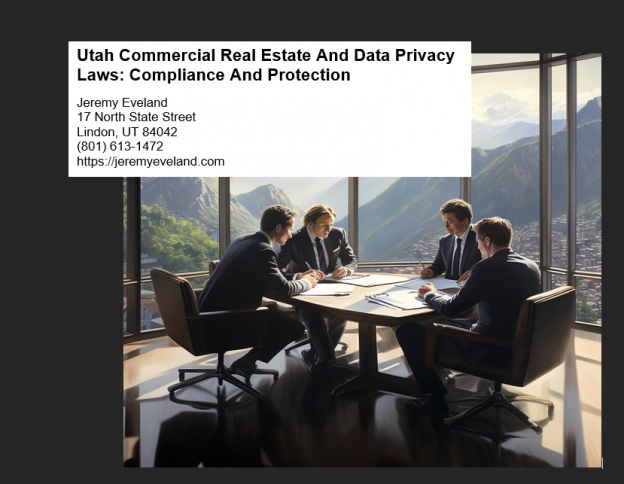Are you involved in the commercial real estate industry in Utah? If so, it’s important to understand the potential environmental liability and compliance issues that may arise. In this article, we will explore the key considerations for Utah commercial real estate owners, developers, and investors when it comes to environmental regulations and compliance. From identifying potential risks and liabilities to navigating the complex regulatory framework, understanding these aspects is crucial to mitigate potential legal and financial consequences. Read on to gain a better understanding of the topic and feel free to reach out to commercial real estate lawyer Jeremy Eveland for personalized legal advice and guidance.
Understanding Environmental Liability in Utah Commercial Real Estate
Commercial real estate owners in Utah face various environmental issues and potential liabilities that can impact their properties and businesses. Understanding these issues and taking proactive measures to mitigate risks is crucial for ensuring compliance with environmental regulations and protecting the property’s value. In this article, we will explore common environmental issues, potential sources of liability, the role of environmental due diligence, relevant regulations, consequences of non-compliance, liability mitigation strategies, the importance of environmental insurance, and the value of consulting an environmental law attorney.
Common Environmental Issues in Commercial Real Estate
Commercial real estate properties in Utah are susceptible to various environmental issues that can pose risks to both the environment and human health. It is essential to be aware of these issues to ensure appropriate measures are taken to address and manage them.
Water Pollution and Contamination
Water pollution and contamination can occur due to improper waste disposal, chemical spills, or inadequate wastewater management systems. Commercial properties near bodies of water, such as rivers or lakes, may have an increased risk of water pollution. Proper handling and disposal of potentially hazardous materials is crucial to prevent water contamination.
Soil Contamination and Hazardous Waste
Soil contamination can result from historical on-site activities, such as chemical storage, fuel leaks, or improper waste disposal. Commercial properties previously used for industrial purposes, gas stations, or manufacturing facilities may have higher risks of soil contamination. Hazardous waste disposal should be conducted according to regulations to prevent further soil contamination and potential health risks.
Air Quality and Emissions
Commercial properties with operations involving industrial processes, such as manufacturing or transportation, may contribute to air pollution through emissions. Controlling emissions and adopting sustainable practices can help improve air quality and minimize environmental impact.
Asbestos and Lead-Based Paint
Older commercial properties may contain asbestos or lead-based paint, both of which can pose significant health risks if disturbed or not properly managed. Identifying and safely removing these materials is crucial to ensuring a healthy and safe environment.
Endangered Species and Habitat Protection
Commercial real estate developments in Utah need to consider potential impacts on endangered species and their habitats. Compliance with federal and state laws protecting these species and their habitats is essential to avoid legal penalties and ensure responsible development practices.

Potential Sources of Environmental Liability
To effectively address and mitigate environmental liabilities, it is important to identify the potential sources of such liabilities. Commercial real estate owners in Utah should be aware of these sources to minimize risks and protect their investments.
Historical Use and Activities on the Property
The historical use and activities conducted on a commercial property can significantly impact its environmental condition. Past practices, such as industrial activities, waste disposal, or improper storage of hazardous materials, may have left behind contamination that can pose risks to both the environment and human health.
Adjacent Contamination
Contamination from neighboring properties can migrate onto a commercial property through soil or groundwater pathways. If neighboring properties have a history of contamination, commercial real estate owners should conduct thorough environmental assessments to identify potential risks and liabilities.
Waste Disposal Practices
Improper waste disposal practices, such as illegal dumping or inadequate management of hazardous waste, can result in environmental contamination. Complying with waste disposal regulations and engaging reputable waste management companies is vital to prevent potential liabilities.
Improper Storage and Handling of Hazardous Materials
Poor storage and handling of hazardous materials can lead to leaks, spills, or accidents that can negatively impact both the environment and human health. Proper training, labeling, and storage protocols should be implemented to minimize the risk of mishandling and associated liabilities.
Non-Compliance with Environmental Regulations
Failure to comply with environmental regulations can result in significant liabilities for commercial real estate owners. It is essential to stay updated on regulations at the federal, state, and local levels, and ensure compliance with all applicable requirements.
The Role of Environmental Due Diligence
Environmental due diligence plays a critical role in assessing potential environmental risks and liabilities associated with commercial real estate properties. It involves conducting thorough assessments and investigations to identify potential chemical, physical, and biological hazards.
Phase I Environmental Site Assessments (ESAs)
Phase I ESAs are a standard practice in commercial real estate transactions. They involve a comprehensive review of property history, site visits, interviews, and records review to identify potential sources of environmental risk and liability. Phase I ESAs provide valuable information about the property’s environmental condition and potential risks.
Phase II Environmental Testing and Remediation
If a Phase I ESA identifies potential areas of concern, a Phase II assessment may be conducted. This phase involves collecting soil, groundwater, or air samples to further investigate and evaluate environmental conditions. If contamination is confirmed, remediation measures can be implemented to mitigate risks and liabilities.
Environmental Impact Assessments (EIAs)
Environmental Impact Assessments are necessary for certain commercial real estate developments to evaluate potential impacts on the environment and surrounding communities. These assessments identify and mitigate potential risks through measures such as land rehabilitation, environmental management plans, and public consultation.
Environmental Compliance Audits
Regular environmental compliance audits help commercial property owners ensure ongoing adherence to environmental regulations. These audits assess the property’s compliance status, identify areas of improvement, and recommend corrective actions to mitigate potential risks and liabilities.
Importance of Professional Environmental Consultants
Engaging qualified environmental consultants is crucial in conducting thorough due diligence and assessments. These professionals have the expertise and experience to identify and evaluate potential environmental risks, ensuring accurate and reliable information to make informed decisions.
Environmental Regulations for Commercial Real Estate in Utah
Commercial real estate owners in Utah need to navigate various federal, state, and local environmental regulations to ensure compliance and avoid potential liabilities. Understanding these regulations is essential for maintaining a safe and environmentally responsible operation.
Utah State Environmental Regulations
Utah has its own set of environmental regulations that impact commercial real estate. These regulations cover areas such as air quality, water pollution, hazardous waste management, environmental remediation, and more. Compliance with these regulations is necessary to avoid legal penalties and protect the environment.
Federal Environmental Regulations
In addition to state regulations, commercial real estate owners in Utah must also comply with federal environmental regulations. Federal laws, such as the Clean Water Act, Clean Air Act, Resource Conservation and Recovery Act (RCRA), and Comprehensive Environmental Response, Compensation, and Liability Act (CERCLA), impose requirements related to pollution prevention, waste management, site cleanup, and more.
Utah-specific Regulations Affecting Commercial Real Estate
Utah has implemented specific regulations and programs to address environmental issues unique to the state. These may include regulations related to water rights, mining operations, oil and gas exploration, and protection of sensitive ecosystems. Staying updated on these regulations is crucial to ensure compliance.
Roles and Responsibilities of Regulatory Agencies
Utah’s Department of Environmental Quality (DEQ), Division of Water Quality (DWQ), Division of Air Quality (DAQ), and other regulatory agencies play a vital role in enforcing environmental regulations. Commercial real estate owners need to be aware of their roles and responsibilities, as well as the reporting and permitting requirements associated with various activities.
Environmental Compliance and Reporting Obligations
Commercial real estate owners in Utah have specific compliance and reporting obligations to fulfill to ensure adherence to environmental regulations. These obligations outline the activities and documentation required to demonstrate compliance and maintain a safe and environmentally responsible operation.
Permits and Approvals
Certain activities in commercial real estate, such as construction, wastewater discharge, or air emissions, may require permits or approvals from regulatory agencies. These permits outline specific requirements and conditions that must be met to ensure compliance.
Environmental Impact Statements
For major developments, an Environmental Impact Statement (EIS) may be required. EIS evaluates the potential environmental impacts of a project and proposes measures to minimize or mitigate adverse effects. It is important to engage environmental consultants and legal professionals to navigate the EIS process effectively.
Waste Handling and Disposal Requirements
Proper handling, storage, and disposal of waste, especially hazardous materials, is essential for environmental compliance. Commercial real estate owners must follow specific requirements regarding waste management systems, labeling, documentation, and disposal methods to prevent contamination and associated liabilities.
Monitoring and Reporting Obligations
Some regulatory permits may require ongoing monitoring and reporting of activities, such as water quality sampling, air emissions monitoring, or waste tracking. Adhering to these obligations helps ensure compliance with environmental regulations and provides valuable data for regulatory agencies.
Recordkeeping Requirements
Accurate and organized recordkeeping is crucial for documenting compliance and demonstrating adherence to environmental regulations. Commercial real estate owners must maintain records related to permits, monitoring data, waste disposal, training programs, and other activities to facilitate inspections and audits.

Consequences of Non-Compliance and Liability
Failure to comply with environmental regulations can have severe consequences for commercial real estate owners in Utah. Understanding the potential risks and liabilities associated with non-compliance is crucial for protecting both the environment and the owner’s financial and legal interests.
Civil and Criminal Penalties
Non-compliance with environmental regulations can result in civil penalties, such as fines or injunctions, imposed by regulatory agencies. In severe cases, criminal charges may be filed, leading to significant fines, imprisonment, or both.
Legal Action and Lawsuits
Non-compliance can also expose commercial real estate owners to legal action and lawsuits from affected parties, such as neighboring property owners, tenants, or employees. These lawsuits can result in costly legal fees, settlements, or judgments against the owner.
Remediation and Cleanup Costs
If a property is found to be contaminated, commercial real estate owners may be responsible for implementing remediation measures and covering the associated costs. Remediation can involve soil and groundwater cleanup, asbestos or lead removal, or other necessary actions to restore the property’s environmental condition.
Loss of Property Value
Environmental contamination and non-compliance can significantly impact a commercial property’s value. Prospective buyers or tenants may be reluctant to engage with a property that has a history of contamination, potentially leading to financial losses for the owner.
Negative Public Image and Reputation Damage
Non-compliance and environmental incidents can negatively impact a commercial real estate owner’s public image and reputation. It can lead to negative media coverage, community backlash, and loss of customer trust, affecting the overall success and viability of the business.
Liability Mitigation Strategies for Commercial Real Estate Owners
Commercial real estate owners can implement various strategies to mitigate environmental liabilities and protect their investments. By taking proactive measures to minimize risks, owners can ensure compliance and maintain a safe and environmentally responsible operation.
Proactive Environmental Management
Developing and implementing an environmental management plan tailored to the specific property’s needs can help identify and address potential risks before they escalate. This includes regular inspections, employee training, waste management protocols, and ongoing monitoring of operations.
Contractual Protections and Indemnification
When entering into contracts or lease agreements, commercial real estate owners should incorporate provisions that protect them from potential environmental liabilities. These provisions may include indemnification clauses, transfer of responsibility for compliance, and insurance requirements from tenants or contractors.
Environmental Liability Insurance
Obtaining environmental liability insurance can provide an additional layer of protection for commercial real estate owners. This type of insurance helps cover costs associated with remediation, legal fees, and damages resulting from environmental incidents, helping mitigate financial risks.
Engaging Environmental Professionals
Collaborating with qualified environmental consultants, attorneys, and insurance experts can provide valuable guidance and expertise in managing environmental risks. These professionals can help identify potential liabilities, develop risk management strategies, and ensure compliance with regulations.
Regular Environmental Audits
Conducting regular environmental audits and assessments can help identify potential compliance issues and mitigate risks before they escalate. These audits evaluate the property’s operations, documentation, and systems to ensure adherence to environmental regulations.

Environmental Insurance and Risk Management
Environmental insurance plays a crucial role in managing the risks associated with commercial real estate properties in Utah. It provides financial protection against potential liabilities and environmental incidents, helping commercial real estate owners safeguard their investments.
Types of Environmental Insurance Coverage
Environmental insurance policies can provide various types of coverage, including pollution liability insurance, remediation cost cap insurance, environmental professional liability insurance, and contractor’s pollution liability insurance. Each type of coverage addresses specific liabilities and risks associated with environmental incidents.
Environmental Risk Assessment and Management
Before obtaining insurance coverage, commercial real estate owners should conduct a comprehensive environmental risk assessment. This assessment helps identify specific risks associated with the property and operations, allowing owners to tailor their insurance coverage to address these risks adequately.
Evaluating and Selecting an Insurance Provider
Choosing the right environmental insurance provider is crucial for ensuring reliable coverage and efficient claims handling. Commercial real estate owners should evaluate insurance providers based on their experience, financial stability, policy terms and conditions, claims handling process, and customer service reputation.
Importance of Consulting an Environmental Law Attorney
Navigating the complexities of environmental regulations and liabilities can be challenging for commercial real estate owners. Seeking guidance from an experienced environmental law attorney can provide valuable support and expertise throughout the process.
Expert Legal Advice and Guidance
Environmental law attorneys specialize in environmental regulations and can provide expert advice tailored to the specific needs of commercial real estate owners. They can help owners understand their obligations, navigate the regulatory landscape, and develop risk management strategies.
Navigating Complex Environmental Regulations
Environmental regulations can be complex, particularly when federal, state, and local laws intersect. Environmental law attorneys can help commercial real estate owners interpret and navigate these regulations, ensuring compliance and minimizing risks of non-compliance.
Negotiating Contracts and Lease Agreements
When entering into contracts or lease agreements involving commercial properties, an environmental law attorney can help owners negotiate terms that protect their interests and limit potential environmental liabilities. They can ensure proper indemnification clauses and compliance requirements are included in the agreements.
Due Diligence and Risk Assessment
Environmental law attorneys can assist commercial real estate owners in conducting thorough due diligence and risk assessments to identify potential environmental liabilities associated with a property or transaction. They can provide guidance on appropriate investigations, assessments, and risk mitigation strategies.
Representation in Environmental Litigation
If environmental litigation arises, having an experienced environmental law attorney by your side is crucial. They can provide representation and advocacy, whether in negotiation, settlement discussions, or litigation, ensuring your interests are protected throughout the process.
Conclusion
Understanding and addressing environmental liability in Utah commercial real estate is vital for property owners to protect their investments and maintain compliance with regulations. By being aware of common environmental issues, potential sources of liability, the importance of environmental due diligence, relevant regulations and reporting obligations, consequences of non-compliance, liability mitigation strategies, the value of environmental insurance, and the importance of seeking legal advice, commercial real estate owners can navigate the complexities of environmental compliance successfully. Engaging experienced professionals, including environmental consultants and environmental law attorneys, can provide the necessary expertise and guidance to ensure a safe, environmentally responsible, and legally compliant operation.







































